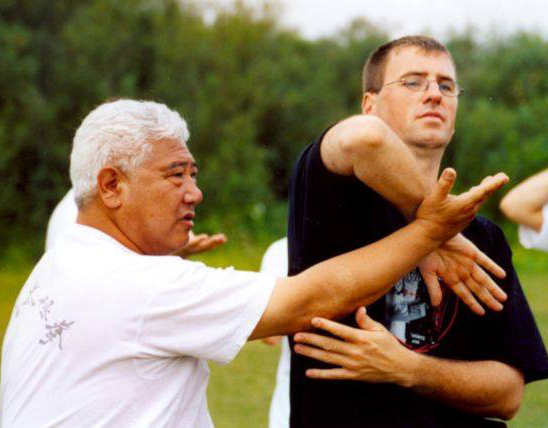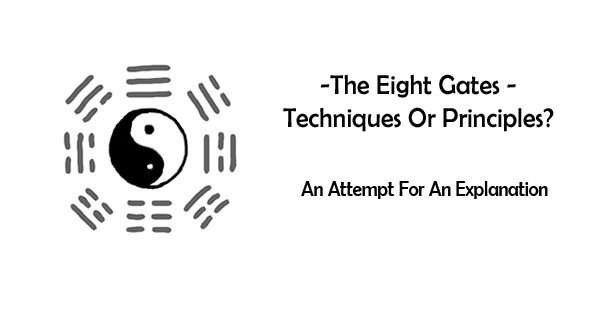The eight gates as techniques
 After the initial use of the eight gates the next decision is how is to proceed with the attack finally. If the other does not react to my probing and goes on with his original attack, the principle of movement changes into a concrete technique, such as:
After the initial use of the eight gates the next decision is how is to proceed with the attack finally. If the other does not react to my probing and goes on with his original attack, the principle of movement changes into a concrete technique, such as:
Peng: I’ll take the force of the other completely and bounce him back with it in a way, that the he loses his balance.
Lü: I let the incoming force fully fall into the emptiness and strike back immediately.
Ji: Since my strength is superior to the other, I press on strongly and throw the other.
An: The other can not change and so I press harder on the empty point of the other until he collapses completely.
Cai: The other stiffens and I pluck harder, until he falls.
Lie: The other can not escape my spiral, he gets completely twisted and loses his balance.
Zhou: The other holds against my strength and gets full. With zhou I find his emptiness and push here or even hit with the elbow.
Kao: The other is surprised by my kao and practically defenseless. A short bump with the torso and the fight is over.
The fusion of principle of movement and technique
All the elegance of the eight gates is found in the word shi. With shi the eight gates are at the same time a movement or strategy principle and a technique which can be used. This shows the extreme subtlety of Tai Chi Chuan and simultaneously explains why it works so amazingly well. With this concept, Tai Chi Chuan is also in accordance with the Chinese strategic thinking:
One has no concrete plan. One tries rather to determine what is possible – what potential the situation of being attacked offers – and which way reveals its self naturally. Then the strategy and technique, which should be employed is almost obvious.
In Tai Chi Chuan, principle and technique are merged into one word. Who, for example, says peng, thinks of the principle, but sees also the technique in his mind’s eye. A small peng to explore – a big peng to uproot. One word – two meanings. One word – two sides of a coin.
The linking of the eight gates
If the other responds to my probing and changes, or e.g. my peng is not able to uproot him completely, I can quickly change to a different one of the eight gates, because I have knowledge of the position and the intensity of the force used by the other. Then the process of feeling and applying begins anew. Change the application of the eight gates between principle of movement and technique, between one gate and the other, back and forth until the other is defeated. As it is said in Yang Banhous Nine Secret Tai Chi Classics:
Change between stillness and movement – why worry.
The two methods of creation and destruction follow each.
[quote]
Below are two books by Martin Boedicker. Click on the images to see more
information about these excellent books!
– Slanted Flying
[/quote]
[/one_fourth]
[one_fourth]
[/one_fourth]
[half_last]
[/half_last]



Leave a Reply